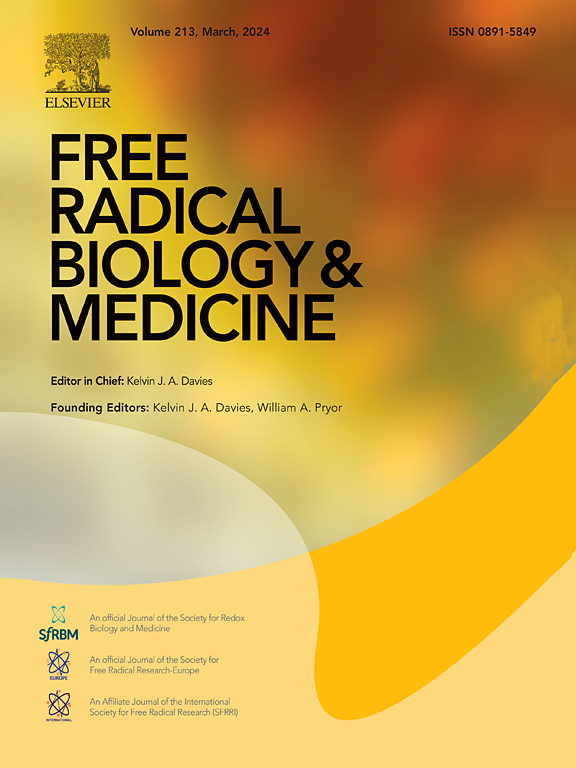Bone morphogenetic protein 4 ameliorates corneal neovascularization by inhibiting NLRP3 inflammasome activation through the promotion of CBP-mediated S100A9 acetylation
IF 7.1
2区 生物学
Q1 BIOCHEMISTRY & MOLECULAR BIOLOGY
引用次数: 0
Abstract
Corneal neovascularization (CoNV), a common pathological consequence of ocular diseases, leads to vision impairment worldwide. Current therapies have a variety of adverse effects. Our previous studies revealed that bone morphogenetic protein 4 (BMP4) attenuates inflammatory neovascularization. However, the underlying mechanism remains unknown. In this study, we explored the potential role of BMP4 in regulating nucleotide-binding oligomerization domain-like receptor family pyrin domain containing 3 (NLRP3) inflammasome-mediated CoNV. Using a rat CoNV model, we showed that BMP4 significantly reduced suture-induced neovascularization. Specifically, BMP4 inhibited NLRP3 inflammasome activation and changed the global acetylation landscape in the corneas of CoNV model rats. Acetylomic analysis revealed that S100 calcium binding protein A9 (S100A9) acetylation at lysine 59 was significantly facilitated by BMP4 treatment. CREB-binding protein (CBP) was identified as the key acetyltransferase mediating the promotion of S100A9 acetylation by BMP4. Acetylated S100A9 interrupted NLRP3 inflammasome activation and ameliorated CoNV. However, subconjunctival A-485 (CBP inhibitor) injection diminished S100A9 acetylation and abolished anti-inflammatory and antiangiogenic BMP4 effects. Collectively, these findings reveal a novel mechanism underlying the antiangiogenic effect of BMP4 through the promotion of CBP-mediated S100A9 acetylation, which inhibits NLRP3 inflammasome activation. Targeting this mechanism might be a promising approach for the prevention and treatment of corneal inflammation and neovascularization.

骨形态发生蛋白4通过促进cbp介导的S100A9乙酰化抑制NLRP3炎性体激活,改善角膜新生血管
角膜新生血管(CoNV)是眼部疾病的常见病理结果,在世界范围内导致视力损害。目前的治疗方法有各种各样的副作用。我们之前的研究表明,骨形态发生蛋白4 (BMP4)可以减轻炎症性新生血管。然而,其潜在机制尚不清楚。在这项研究中,我们探索了BMP4在调节含有3 (NLRP3)炎症小体介导的CoNV中的潜在作用。通过大鼠CoNV模型,我们发现BMP4显著减少了缝合线诱导的新生血管。具体来说,BMP4抑制了NLRP3炎性体的激活,改变了CoNV模型大鼠角膜的整体乙酰化格局。乙酰组学分析显示,BMP4处理显著促进了S100钙结合蛋白A9 (S100A9)赖氨酸59位点的乙酰化。creb结合蛋白(creb binding protein, CBP)是BMP4介导S100A9乙酰化的关键乙酰转移酶。乙酰化的S100A9阻断了NLRP3炎症小体的激活并改善了CoNV。然而,结膜下A-485 (CBP抑制剂)注射减少了S100A9乙酰化并消除了抗炎和抗血管生成BMP4的作用。总之,这些发现揭示了BMP4通过促进cbp介导的S100A9乙酰化而抑制NLRP3炎性体激活的抗血管生成作用的新机制。针对这一机制可能是预防和治疗角膜炎症和新生血管的一种有希望的方法。
本文章由计算机程序翻译,如有差异,请以英文原文为准。
求助全文
约1分钟内获得全文
求助全文
来源期刊

Free Radical Biology and Medicine
医学-内分泌学与代谢
CiteScore
14.00
自引率
4.10%
发文量
850
审稿时长
22 days
期刊介绍:
Free Radical Biology and Medicine is a leading journal in the field of redox biology, which is the study of the role of reactive oxygen species (ROS) and other oxidizing agents in biological systems. The journal serves as a premier forum for publishing innovative and groundbreaking research that explores the redox biology of health and disease, covering a wide range of topics and disciplines. Free Radical Biology and Medicine also commissions Special Issues that highlight recent advances in both basic and clinical research, with a particular emphasis on the mechanisms underlying altered metabolism and redox signaling. These Special Issues aim to provide a focused platform for the latest research in the field, fostering collaboration and knowledge exchange among researchers and clinicians.
 求助内容:
求助内容: 应助结果提醒方式:
应助结果提醒方式:


